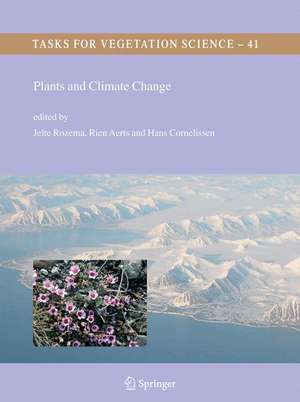Plants and Climate Change: Tasks for Vegetation Science, cartea 41
Editat de Jelte Rozema, Rien Aerts, Hans Cornelissenen Limba Engleză Hardback – 21 aug 2006
The papers highlight plant responses to atmospheric CO2 increase, to global warming and to increased ultraviolet-B radiation as a result of stratospheric ozone depletion.
Depending on how and how well plant responses to increased temperature, atmospheric CO2 and ultraviolet-B have been preserved in the (sub)-fossil record, past climates and past atmospheric chemistry may be reconstructed. Pollen and tree-ring data reflect plant species composition and variation of temperature and precipitation over long or shorter time intervals. In addition to well preserved morphological and chemical plant properties, new analytical techniques such as stable isotopes are becoming increasingly important in this respect. The development and validation of such biotic climate and environment proxies build a bridge between biological and geological research. This highlights that plant-climate change research is becoming a multi- and transdisciplinary field of relevant research.
| Toate formatele și edițiile | Preț | Express |
|---|---|---|
| Paperback (1) | 951.59 lei 6-8 săpt. | |
| SPRINGER NETHERLANDS – 19 noi 2010 | 951.59 lei 6-8 săpt. | |
| Hardback (1) | 954.31 lei 6-8 săpt. | |
| SPRINGER NETHERLANDS – 21 aug 2006 | 954.31 lei 6-8 săpt. |
Din seria Tasks for Vegetation Science
-
 Preț: 34.59 lei
Preț: 34.59 lei - 18%
 Preț: 1219.16 lei
Preț: 1219.16 lei - 20%
 Preț: 554.66 lei
Preț: 554.66 lei -
 Preț: 394.12 lei
Preț: 394.12 lei -
 Preț: 396.02 lei
Preț: 396.02 lei -
 Preț: 402.76 lei
Preț: 402.76 lei - 24%
 Preț: 790.13 lei
Preț: 790.13 lei - 18%
 Preț: 1825.75 lei
Preț: 1825.75 lei - 18%
 Preț: 1218.69 lei
Preț: 1218.69 lei - 24%
 Preț: 784.53 lei
Preț: 784.53 lei - 18%
 Preț: 1233.69 lei
Preț: 1233.69 lei -
 Preț: 73.90 lei
Preț: 73.90 lei - 18%
 Preț: 1222.01 lei
Preț: 1222.01 lei - 18%
 Preț: 952.09 lei
Preț: 952.09 lei - 18%
 Preț: 1225.94 lei
Preț: 1225.94 lei -
 Preț: 388.31 lei
Preț: 388.31 lei -
 Preț: 391.40 lei
Preț: 391.40 lei - 18%
 Preț: 1220.45 lei
Preț: 1220.45 lei - 18%
 Preț: 949.23 lei
Preț: 949.23 lei - 18%
 Preț: 943.73 lei
Preț: 943.73 lei - 18%
 Preț: 1238.11 lei
Preț: 1238.11 lei - 18%
 Preț: 1232.26 lei
Preț: 1232.26 lei - 24%
 Preț: 796.72 lei
Preț: 796.72 lei - 24%
 Preț: 1068.94 lei
Preț: 1068.94 lei -
 Preț: 368.39 lei
Preț: 368.39 lei - 18%
 Preț: 1230.03 lei
Preț: 1230.03 lei - 24%
 Preț: 783.41 lei
Preț: 783.41 lei - 18%
 Preț: 948.16 lei
Preț: 948.16 lei - 18%
 Preț: 948.61 lei
Preț: 948.61 lei - 24%
 Preț: 1053.39 lei
Preț: 1053.39 lei
Preț: 954.31 lei
Preț vechi: 1163.80 lei
-18% Nou
Puncte Express: 1431
Preț estimativ în valută:
182.60€ • 191.68$ • 151.57£
182.60€ • 191.68$ • 151.57£
Carte tipărită la comandă
Livrare economică 10-24 aprilie
Preluare comenzi: 021 569.72.76
Specificații
ISBN-13: 9781402044427
ISBN-10: 1402044429
Pagini: 272
Ilustrații: VIII, 264 p.
Dimensiuni: 210 x 279 x 20 mm
Greutate: 0.7 kg
Ediția:2006
Editura: SPRINGER NETHERLANDS
Colecția Springer
Seria Tasks for Vegetation Science
Locul publicării:Dordrecht, Netherlands
ISBN-10: 1402044429
Pagini: 272
Ilustrații: VIII, 264 p.
Dimensiuni: 210 x 279 x 20 mm
Greutate: 0.7 kg
Ediția:2006
Editura: SPRINGER NETHERLANDS
Colecția Springer
Seria Tasks for Vegetation Science
Locul publicării:Dordrecht, Netherlands
Public țintă
ResearchCuprins
Global climate change: atmospheric CO2 enrichment, global warming and stratospheric ozone depletion.- Responses of terrestrial Antarctic ecosystems to climate change.- Atmospheric CO2 enrichment.- Vascular plant responses to elevated CO2 in a temperate lowland Sphagnum peatland.- Moss responses to elevated CO2 and variation in hydrology in a temperate lowland peatland.- From transient to steady-state response of ecosystems to atmospheric CO2-enrichment and global climate change: conceptual challenges and need for an integrated approach.- Plant performance in a warmer world: general responses of plants from cold, northern biomes and the importance of winter and spring events.- Global warming.- Stable isotope ratios as a tool for assessing changes in carbon and nutrient sources in Antarctic terrestrial ecosystems.- Upscaling regional emissions of greenhouse gases from rice cultivation: methods and sources of uncertainty.- Stratospheric ozone depletion.- Effects of enhanced UV-B radiation on nitrogen fixation in arctic ecosystems.- Stratospheric ozone depletion: high arctic tundra plant growth on Svalbard is not affected by enhanced UV-B after 7 years of UV-B supplementation in the field.- Outdoor studies on the effects of solar UV-B on bryophytes: overview and methodology.- Reconstruction of Past Climates using plant derived proxies.- A vegetation, climate and environment reconstruction based on palynological analyses of high arctic tundra peat cores (5000–6000 years BP) from Svalbard.- Physiognomic and chemical characters in wood as palaeoclimate proxies.- The occurrence of p-coumaric acid and ferulic acid in fossil plant materials and their use as UV-proxy.- Biomacromolecules of algae and plants and their fossil analogues.
Recenzii
From the reviews:
"The book ‘Plants and Climate Change’ is comprised of contributions to a symposium entitled ‘Plants and (Present and Past) Climate Change’, which originally was published in the journal ‘Plant Ecology’. … In the context of far northern ecosystems and wetlands, the book provides interesting and useful summaries that update and provide additional new perspectives required to better understand these systems. … an important extension and provide new insight on ecosystems intensively under study since the International Biological Programme, IBP." (J. Tenhunen and G.-R. Walther, Phytocoenologia, Vol. 38 (1-2), August, 2008)
"The book ‘Plants and Climate Change’ is comprised of contributions to a symposium entitled ‘Plants and (Present and Past) Climate Change’, which originally was published in the journal ‘Plant Ecology’. … In the context of far northern ecosystems and wetlands, the book provides interesting and useful summaries that update and provide additional new perspectives required to better understand these systems. … an important extension and provide new insight on ecosystems intensively under study since the International Biological Programme, IBP." (J. Tenhunen and G.-R. Walther, Phytocoenologia, Vol. 38 (1-2), August, 2008)
Textul de pe ultima copertă
The book Plants and Climate Change focuses on how climate affects or affected the biosphere and vice versa both in the present and past. The chapters describe how ecosystems from the Antarctic and arctic and from other latitudes respond to global climate change.
The book covers papers highlighting plant responses to atmospheric CO2 increase, to global warming and to increased ultraviolet-B radiation as a result of stratospheric ozone depletion.
Depending on how and how well plant responses to increased temperature, atmospheric CO2 and ultraviolet-B have been preserved in the (sub)-fossil record, past climates and past atmospheric chemistry may be reconstructed. Pollen and tree-ring data reflect plant species composition and variation of temperature and precipitation over long or shorter time intervals. In addition to well preserved morphological and chemical plant properties, new analytical techniques such as stable isotopes are becoming increasingly important in this respect. The development and validation of such biotic climate and environment proxies build a bridge between biological and geological research. This highlights that plant-climate change research is becoming a multi- and transdisciplinary field of relevant research.
Reprinted from Plant Ecology, 182:1-2 (2006).
The book covers papers highlighting plant responses to atmospheric CO2 increase, to global warming and to increased ultraviolet-B radiation as a result of stratospheric ozone depletion.
Depending on how and how well plant responses to increased temperature, atmospheric CO2 and ultraviolet-B have been preserved in the (sub)-fossil record, past climates and past atmospheric chemistry may be reconstructed. Pollen and tree-ring data reflect plant species composition and variation of temperature and precipitation over long or shorter time intervals. In addition to well preserved morphological and chemical plant properties, new analytical techniques such as stable isotopes are becoming increasingly important in this respect. The development and validation of such biotic climate and environment proxies build a bridge between biological and geological research. This highlights that plant-climate change research is becoming a multi- and transdisciplinary field of relevant research.
Reprinted from Plant Ecology, 182:1-2 (2006).
Caracteristici
Ecosystem responses to climate change Plant responses as environment and climate proxies The use of plant responses in climate reconstructions Climate change, responses of plants from the Antarctic and arctic Scaling up from ecophysiology- ecosystems- landscape- biosphere










